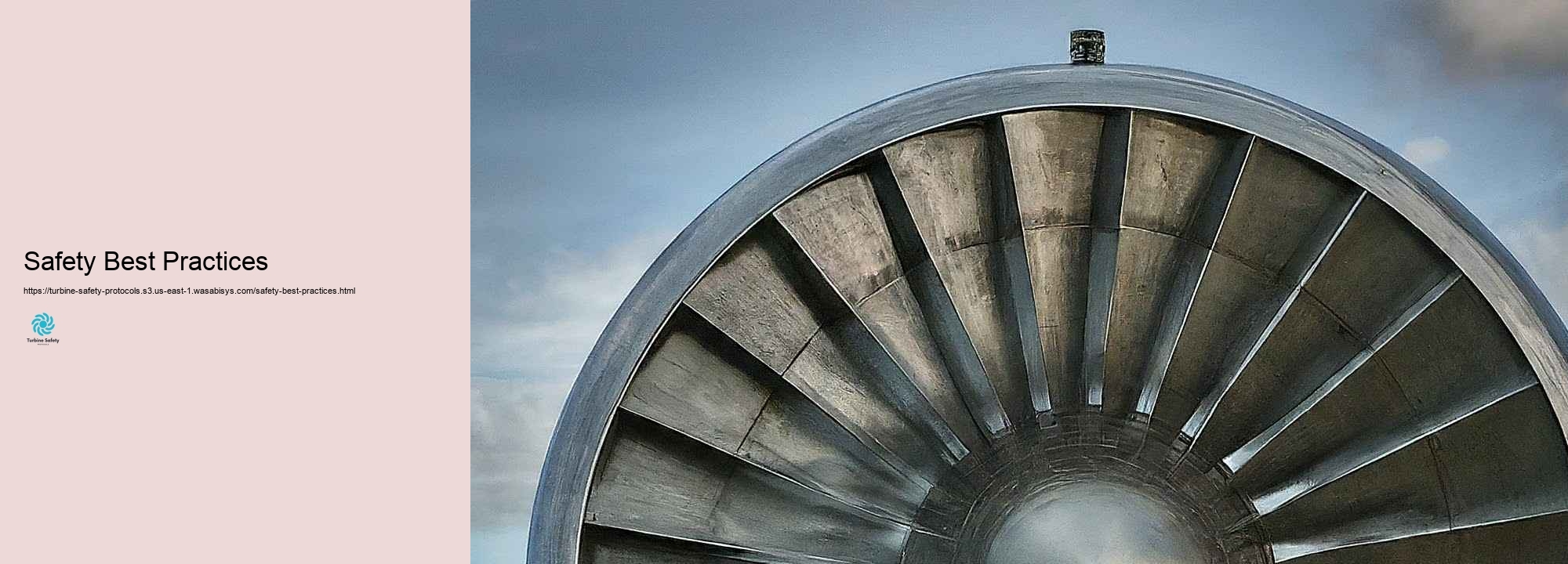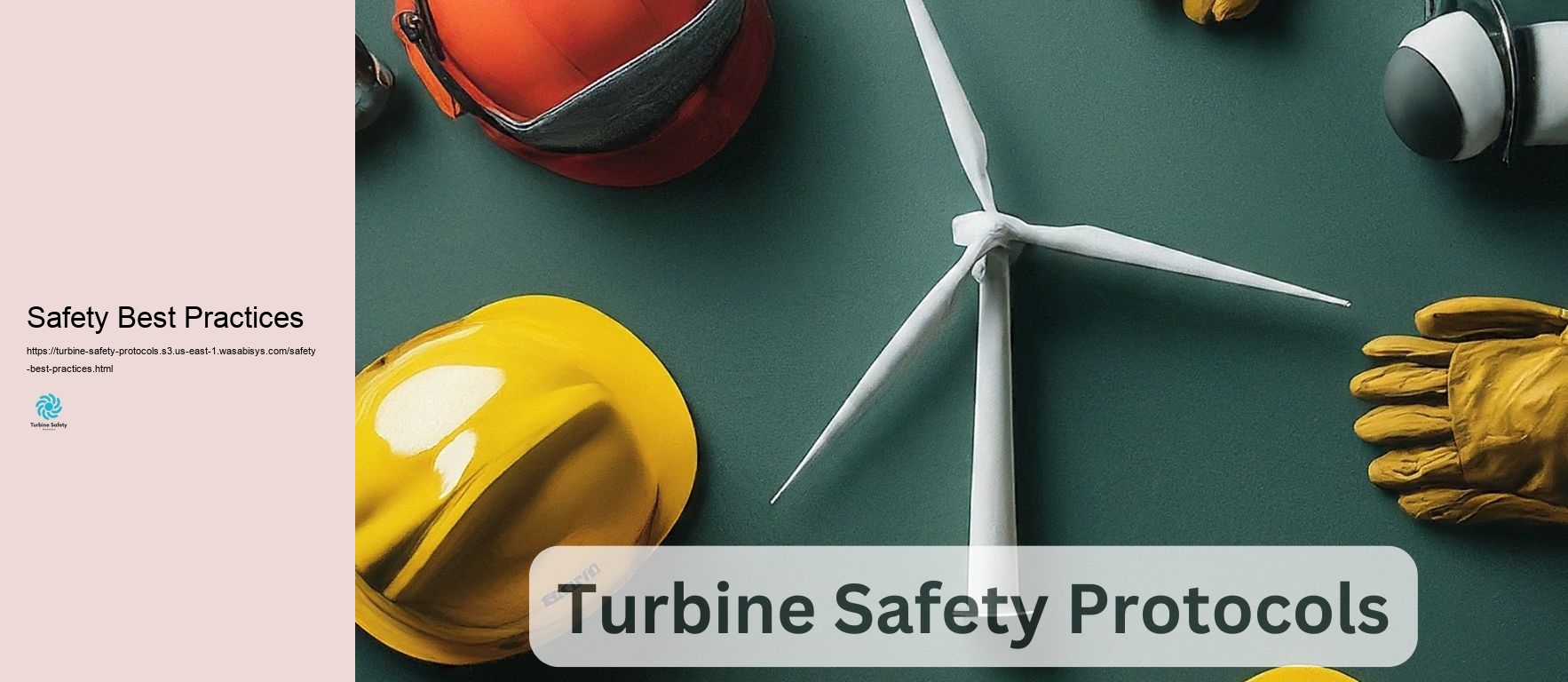

Turbine safety protocols are essential parts of power generation procedures, made to protect employees, tools, and the atmosphere from possible risks connected with turbine treatment.
Wind generators are important aspects in power generation, and their risk-free treatment and upkeep are vital to make sure the dependability of power supply and the safety of workers. Turbine upkeep and treatment entail a variety of jobs that, if not implemented appropriately, can bring about incidents, injuries, and also casualties. Consequently, sticking to important safety treatments is vital to minimize hazards and make certain a risk-free workplace. Prior to any type of kind of upkeep job starts, it is necessary to perform thorough pre-maintenance checks. These checks include analyzing the turbine's useful history, inspecting the turbine and its parts for any type of sort of indicators of wear or damages, and ensuring that all required safety devices is available and in great trouble. In addition, all employees associated with the maintenance should be correctly trained and aware of the details safety treatments associated with the turbine version and the work offered. Among among one of the most important safety treatments in turbine maintenance is the lockout/tagout(LOTO )treatment. This treatment makes certain that the turbine is safely de-energized and can not be started inadvertently throughout upkeep. LOTO consists of physically securing the turbine's power source and identifying it to sharp others that maintenance remains in progression. This action is vital to prevent unexpected startup, which can cause extreme injuries or casualties. Private Safety Devices (PPE) is essential for protecting workers from numerous risks during turbine upkeep and procedure. PPE consists of hard hats, shatterproof glass, gloves, earplugs, and respirators. Each piece of PPE serves a particular purpose, such as securing the head from dropping points, safeguarding the eyes from particles, or stopping hearing damage from loud noises. Making sure that all employees wear the suitable PPE is essential to reduce the risk of injury. Turbine maintenance often needs going into restricted rooms, such as the turbine casing or piping systems. Constrained space entryway positions considerable risks, including asphyxiation, surge, and entrapment. As a result, it is vital to stick to strenuous safety protocols for constrained space accessibility, containing acquiring proper licenses, taking advantage of ideal ventilation systems, and ensuring consistent keeping an eye on of the atmosphere within the restricted area. Electric safety is a vital aspect of turbine maintenance and procedure. Wind turbines are powered by high-voltage electric systems, which can be hazardous if not managed correctly. Making certain that all electrical systems are de-energized prior to upkeep, using protected tools, and complying with proper basing treatments are essential to avoid electrical shocks and accidents. Fire safety is another important worry in turbine maintenance and procedure. Generators and their connected systems can produce promotes or warm, which can stir up flammable materials. Making sure that fire extinguishers are conveniently readily available, preserving a tidy and clutter-free work area, and adhering to appropriate warm work licenses are vital to prevent fires. Normal training and drills are important to make certain that all employees understand with safety treatments and can respond effectively in emergency scenarios. Training must cover all components of turbine upkeep and procedure, including LOTO treatments, PPE usage, restricted area gain access to protocols, electrical safety, and fire safety. Accomplishing regular drills aids to enhance this understanding and ensures that staff members can act swiftly and properly in circumstances of an emergency. Consistent monitoring and enhancement of safety procedures are essential to ensure that they remain to be efficient and relevant. This consists of routinely examining safety protocols, updating treatments as vital, and incorporating lessons picked up from cases or near loses out on. Constant improvement helps to keep a society of safety within the organization and makes sure that all personnel are committed to sticking to crucial safety procedures. Ensuring the risk-free procedure and maintenance of generators demands a detailed method that consists of pre-maintenance checks, lockout/tagout treatments, personal safety equipment,
restricted room accessibility protocols, electric safety, fire safety, regular training and drills, and constant security and restoration. By sticking to these vital safety procedures, firms can drastically decrease the threat of accidents and injuries, making certain a risk-free working environment for all personnel related to turbine maintenance and operation.
Safety Best Practices - Safety Signage
- Job Safety Analysis (JSA)
- Electrical Safety Procedures
- Safety Protocol Implementation
- Turbine Blade Safety
Ensuring the safety of wind turbine operations is non-negotiable! From rigorous safety protocols to continuous monitoring, every step counts in protecting our workforce and maintaining operational integrity.https://t.co/6qMvcBwr4R
— Turbine Training And Operation (@turbinetraine) August 20, 2024
Making certain the safety of workers servicing and around wind generators is essential in the wind power market. Using reliable turbine safety protocols is vital for quiting accidents, protecting staff members, and keeping the honesty of wind power procedures. This detailed overview explains the process of producing and executing substantial safety protocols for wind turbine procedures. The main step in carrying out efficient turbine safety protocols is to perform a comprehensive threat analysis. This involves determining all potential hazards gotten in touch with turbine operation, maintenance, and fixing service. Regular dangers contain drops from elevation, electrical dangers, mechanical dangers from transferring elements, and eco-friendly risks such as serious environment problem. The hazard assessment require to be extensive, covering all aspects of turbine work from ground operations to nacelle gain access to and blade upkeep. As soon as threats are identified, the following step is to establish particular safety procedures to resolve each figured out risk. These procedures need to be defined and cover all aspects of turbine work. As an example, protocols for operating at altitude should contain needs for autumn protection gadgets, treatments for shielding gadgets, and requirements for secure climb and descent of the turbine tower. Risk Assessment Electrical safety therapies must info lockout/tagout treatments, correct use protected tools, and emergency circumstance action get ready for electrical incidents. Training is a vital element of using safety protocols. All employees servicing or around wind generators have to get thorough safety training. This training ought to cover basic safety concepts in addition to information therapies relevant to their duties. It's important to contain both academic comprehending and functional capacities training. As an example, staff members should certainly not just understand the significance of fall protection but furthermore be proficient in properly placing on and utilizing harnesses and various other safety equipment. Establishing a clear pecking order and communication system is the complying with crucial step. This requires assigning safety law enforcement officer, defining features and responsibilities for all employee, and establishing clear interaction protocols. Emergency scenario action procedures must be plainly specified, including precisely just how to phone call emergency scenario remedies and leave damaged personnel from the turbine. Routine safety conferences and directions require to be set up to ensure persisting interaction pertaining to safety issues and updates to protocols. Performing a long lasting system for private safety devices (PPE) is important. This entails not just offering ideal PPE such as hard hats, shatterproof glass, handwear covers, and loss protection tools however in addition making certain that all devices is properly kept, analyzed consistently, and transformed when vital. Clear requirements require to be developed for when and simply exactly how PPE requirements to be used, and there should be no resistance for non-compliance with PPE requirements. Developing a society of safety is vital for the success of any type of kind of safety procedure. This includes cultivating an atmosphere where safety is everyone responsibility and where staff members truly feel complete to speak up about safety problems without concern of . Leadership requirements to visibly maintain and focus on safety, establishing an instance for all personnel. Carrying out an incentive system for safety compliance and growth can help reinforce the importance of safety in everyday procedures. Regular safety audits and evaluations are important for maintaining reliable safety protocols. These must be carried out at established periods and must cover all aspects of turbine procedures. Audits must analyze consistency with identified safety treatments, the condition of safety devices, and the overall safety society of the company. Any kind of sort of worries recognized during these audits must be took care of rapidly, with clear activity strategies and follow-up therapies. Producing and using an incident reporting and exam system is one more crucial action. All accidents, near-misses, and safety concerns should certainly be reported and totally examined. This system ought to be made to determine origin of cases and to develop safety nets to prevent similar incidents in the future. It's important to develop a setting where reporting is urged and seen as a beneficial action towards enhancing general safety. Integrating innovation right into safety protocols can substantially enhance their effectiveness. This may consist of utilizing drones for turbine evaluations to reduce the demand for dangerous climbs up, executing electronic systems for safety checklists and insurance coverage, or using wearable modern-day innovation to monitor worker safety in real-time. As brand-new developments arise, safety protocols should be updated to integrate these improvements. Partnership with turbine providers and industry partners is an important aspect of using reliable safety protocols. This requires staying updated with maker referrals for risk-free treatment and maintenance, together with joining market on-line discussion forums and working teams concentrated on safety. Sharing suitable techniques and lessons learnt with different other operators can aid increase safety throughout the field. Weather condition tracking and reaction protocols are essential for wind turbine safety. This includes carrying out systems to monitor local environment condition and developing clear guidelines for when to put on hold treatments as a result of unfavorable weather condition. Treatments should certainly be in area for safeguarding tools and evacuating workers in instance of extreme climate occasions. Establishing protocols for managing tiredness and anxiousness among employees is one more vital action. Servicing wind generators can be literally and emotionally requiring, and exhaustion can substantially increase the risk of accidents. Carrying out work-rest timetables, providing adequate breaks, and tracking staff member tiredness levels are really essential elements of an extensive safety approach. Normal examination and upgrade of safety protocols is necessary to make sure they remain to be reliable and appropriate. This needs to be done a minimum of annually, or a great deal even more on a regular basis if there are significant adjustments in operations, tools, or laws. The examination treatment ought to include input from employees in all degrees, along with factor to take into consideration of market finest techniques and any kind of lessons picked up from occasions or near-misses. It's necessary to develop metrics for gauging the efficiency of safety protocols. This could include tracking situation rates, consistency with safety treatments, and involvement in safety training. Normal reporting on these metrics can aid identify areas for improvement and show the business dedication to safety. Implementing reliable turbine safety protocols is a considerable procedure that calls for ongoing dedication and interest. By complying with these actions, wind power drivers can create a durable safety culture that secures workers, reduces threats, and adds to the general success and sustainability of wind power operations. Keep in mind, safety is not an one-time implementation yet a continuous procedure of renovation and wariness.
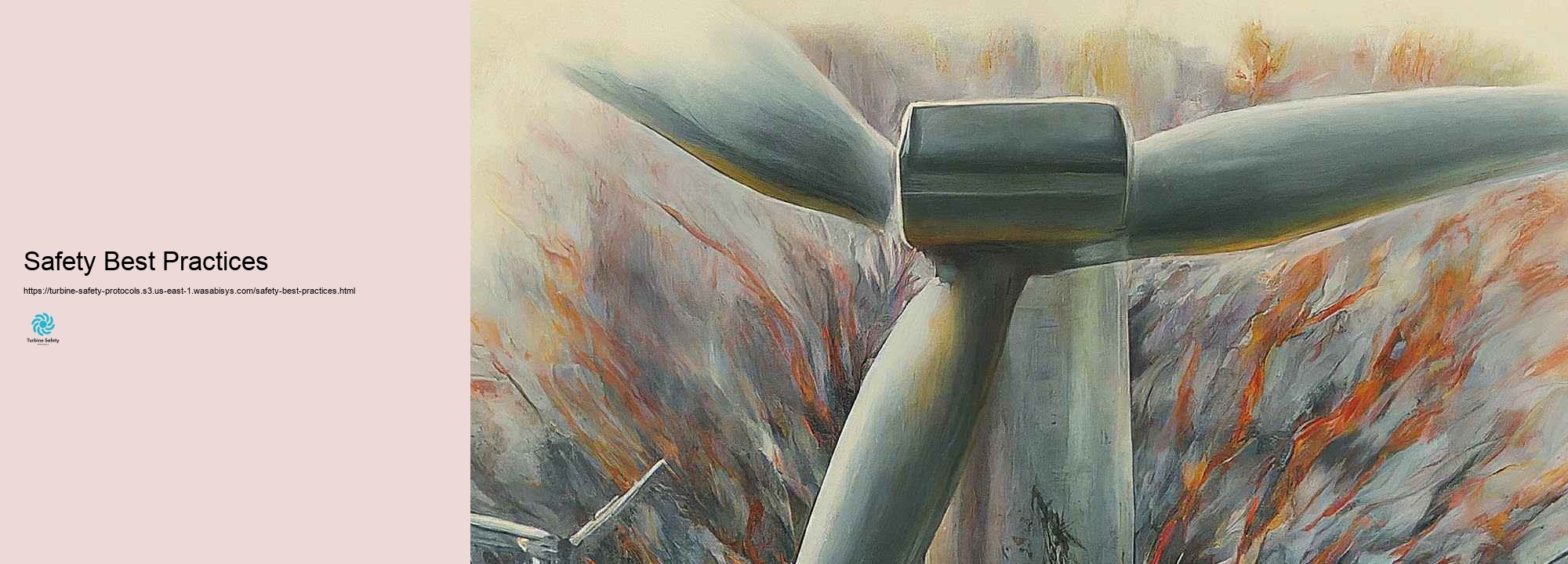
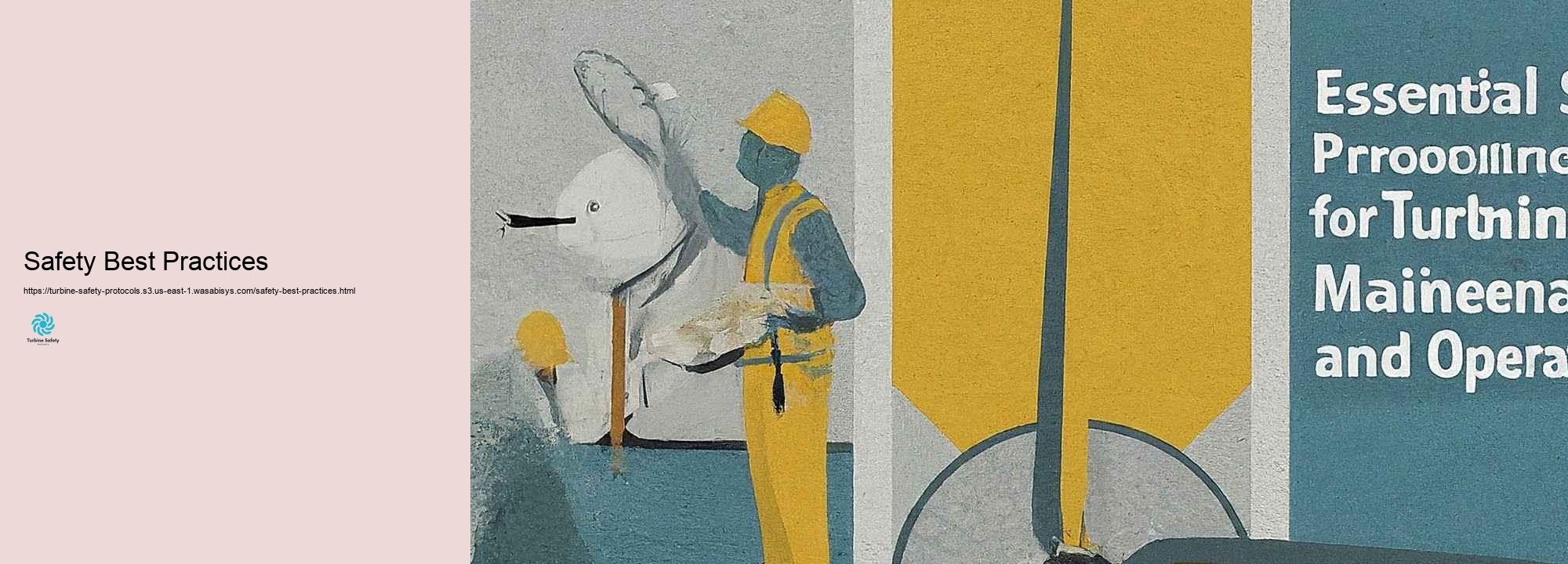
Safety standards and conformity are essential in turbine operations, whether in wind, hydroelectric, or thermal power plants. These requirements are established to safeguard employees, ensure operational integrity, and reduction ecological impacts. Complying with these criteria is not merely a lawful demand yet in addition an essential element of maintaining reliable and lasting power producing. Among the major safety standards in turbine procedures is the Occupational Safety and Health and wellness And Health Administration (OSHA) requirements. These criteria cover a wide variety of safety aspects, consisting of autumn defense, electric safety, and threat communication. For wind turbines, OSHA has specific requirements managing the special challenges of operating at elevations and in constrained locations. Consistency with OSHA standards involves routine safety audits, ideal training of employees, and application of safety protocols tailored to the particular risks connected with turbine operations. The International Electrotechnical Commission (IEC) deals an extra set of important requirements for turbine safety, especially for wind wind turbines. The IEC 61400 collection of requirements covers numerous elements of wind turbine design, installment, and operation. These requirements address issues such as architectural sincerity, electrical systems, and performance analysis. Consistency with IEC standards is usually a need for certification and is vital for ensuring the honesty and safety of wind turbine operations. For hydroelectric wind turbines, the Federal Energy Regulatory Payment (FERC) in the U.S.A. state extensive safety standards. These standards cover dam safety, emergency task approaches, and functional treatments. Compliance with FERC standards entails routine examinations, upkeep of safety tools, and growth of long lasting emergency response protocols. In the world of thermal nuclear power plant, the American Society of Mechanical Designers (ASME) materials essential safety requirements for turbine operations. The ASME Central Heating Boiler and Anxiety Vessel Code is specifically relevant, addressing the layout, building, and evaluation of pressure-containing parts in thermal power plants. Adherence to these requirements is vital for preventing catastrophic failings and guaranteeing the lasting honesty of turbine systems. Ecological conformity is one more essential component of turbine procedures. For wind generators, this regularly includes adherence to wild animals protection criteria, such as those recognized by the UNITED STATE Fish and Wildlife Solution. These needs unbiased to reduce the impact of wind ranches on bird and bat populaces. Consistency may involve using wild animals keeping track of programs, transforming turbine treatments throughout migration periods, and using contemporary technologies to prevent wildlife collisions.
Turbine safety is an important facet of wind power procedures, including a vast array of methods and therapies made to secure staff members, tools, and the establishing. As wind generators continue to expand in dimension and intricacy, carrying out and sticking to ideal safety approaches ends up being considerably essential. This short post finds key strategies and techniques for reducing risks and securing versus mishaps in turbine procedures and upkeep. Amongst the crucial concepts of turbine safety is considerable danger analysis. Prior to any type of type of job is performed on or around a turbine, a full evaluation of prospective threats need to be conducted. This contains analyzing environmental problems, such as wind price and weather condition prediction, in addition to the certain risks pertaining to the work useful. Threat evaluations ought to be lively, continually upgraded to mirror changing problems or new details, and engaged plainly to all employees related to the procedure. Personal Safety Devices (PPE) is a vital aspect of turbine safety. Workers need to be geared up with appropriate safety devices, consisting of construction hats, unbreakable glass, gloves, and steel-toed boots. For operate at elevations, specialized autumn security equipment is required. This frequently consists of full-body harnesses, lanyards, and assistance points. Normal analysis and upkeep of PPE are important to make certain its efficiency. Training in the correct use and treatment of safety devices is just as crucial, as also the best equipment is only reliable when utilized properly. Working at elevations presents amongst one of one of the most substantial risks in turbine treatments. Finest techniques for altitude safety consist of making use of fall arrest systems, right ladder safety protocols, and the application of rescue strategies. Several wind ranches are now welcoming innovative gain access to systems, such as remedy lifts, to reduce the hazards associated with ladder goes up. Normal training in elevation safety and rescue procedures is important, containing functional exercises and simulations of emergency situations. Electric safety is one more critical location in turbine treatments. Wind turbines include high-voltage systems, and taking care of or around these systems calls for specialized expertise and preventative measures. Lock-out/tag-out therapies are essential when executing upkeep on electric systems to make sure that devices is successfully de-energized before job starts. Simply certified and accredited workers ought to service electrical systems, and regular electric safety training should certainly be supplied to all essential personnel. Weather play a substantial duty in turbine safety. High winds, lightning, and serious temperature levels can all position serious risks to employees and devices. Performing clear weather-related task protocols is important. This might consist of developing wind rate constraints for sure activities, establishing lightning safety treatments, and giving criteria for operating in severe warm or cool. Real-time climate security systems can help operators make informed options concerning when it is protected to implement particular tasks. Restricted space entry is an additional area of problem in turbine safety. A number of parts of a wind turbine, such as the nacelle or center, can be determined as constrained spaces. Access right into these places ask for particular safety therapies, containing atmospheric evaluating, air flow, and taking advantage of a standby person. Appropriate training in constricted space accessibility and rescue is essential for any kind of workers that could need to run in these areas. Crane and elevating operations are typically required for turbine maintenance and element replacement. These treatments carry considerable risks and demand cautious preparing and execution. Finest methods include comprehensive tools evaluations, clear interaction protocols, and making use of certified chauffeurs. Load estimations, wind price checking, and proper rigging techniques are all important aspects of safe training procedures. Emergency reaction intending is a vital element of turbine safety. Every wind farm ought to have a thorough emergency scenario action technique that covers various circumstances, containing clinical emergency situation circumstances, fires, and extreme climate occasions. Normal drills and simulations help guarantee that all employees know with emergency treatments and can respond properly in a crisis. Interaction is vital to keeping safety in turbine treatments. Clear and constant interaction protocols has to be established for all activities, specifically those consisting of numerous staff member or complicated treatments. This includes the use of standardized hand signals, radio interactions, and pre-task instructions. Language challenges need to be took care of, especially on international jobs where workers may come from varied backgrounds. Upkeep and evaluation regimens play a crucial feature in protecting versus crashes. Regular exams of turbine parts, safety devices, and access to systems can help acknowledge possible worries prior to they cause problems. Executing a sturdy precautionary upkeep program not simply boosts safety yet likewise improves the general reliability and performance of the turbine. Human aspects and tiredness management are very important variables to take into consideration in turbine safety. Long changes, challenging manual labor, and the psychological needs of operating at elevations can all add to fatigue, which can improve the danger of incidents. Accomplishing suitable work-rest timetables, supplying adequate breaks, and monitoring worker exhaustion degrees are essential methods for maintaining safety.
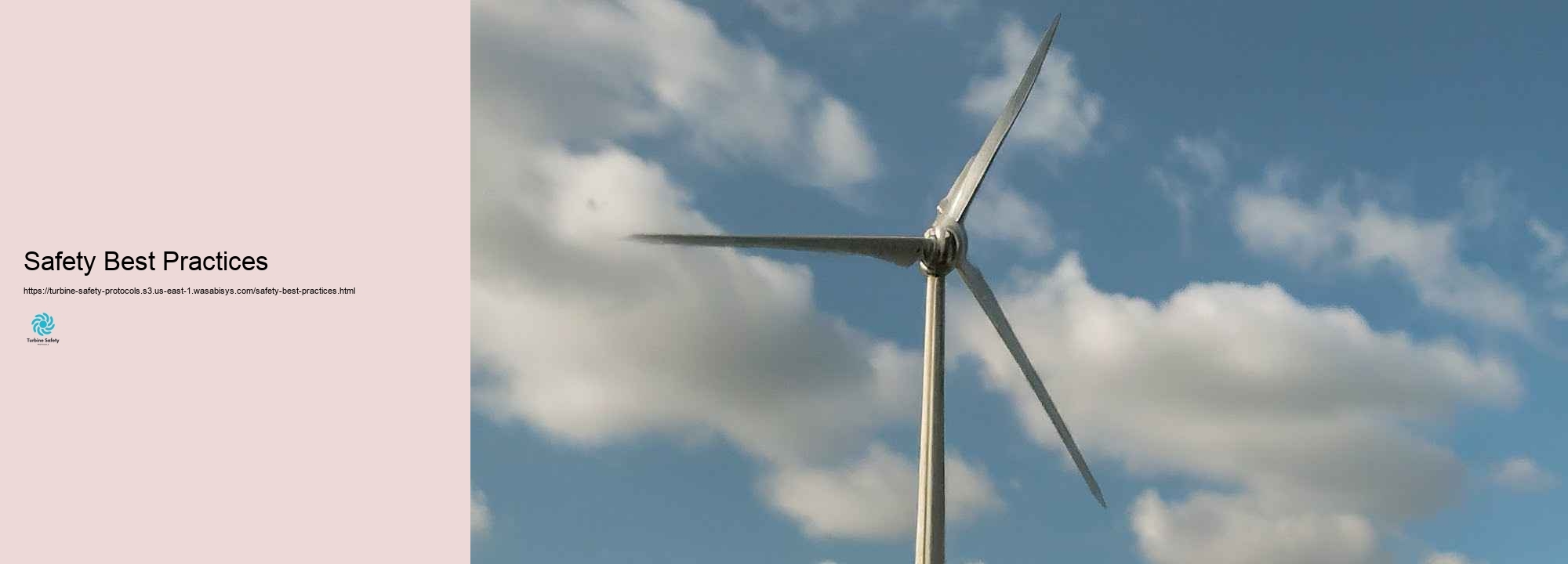
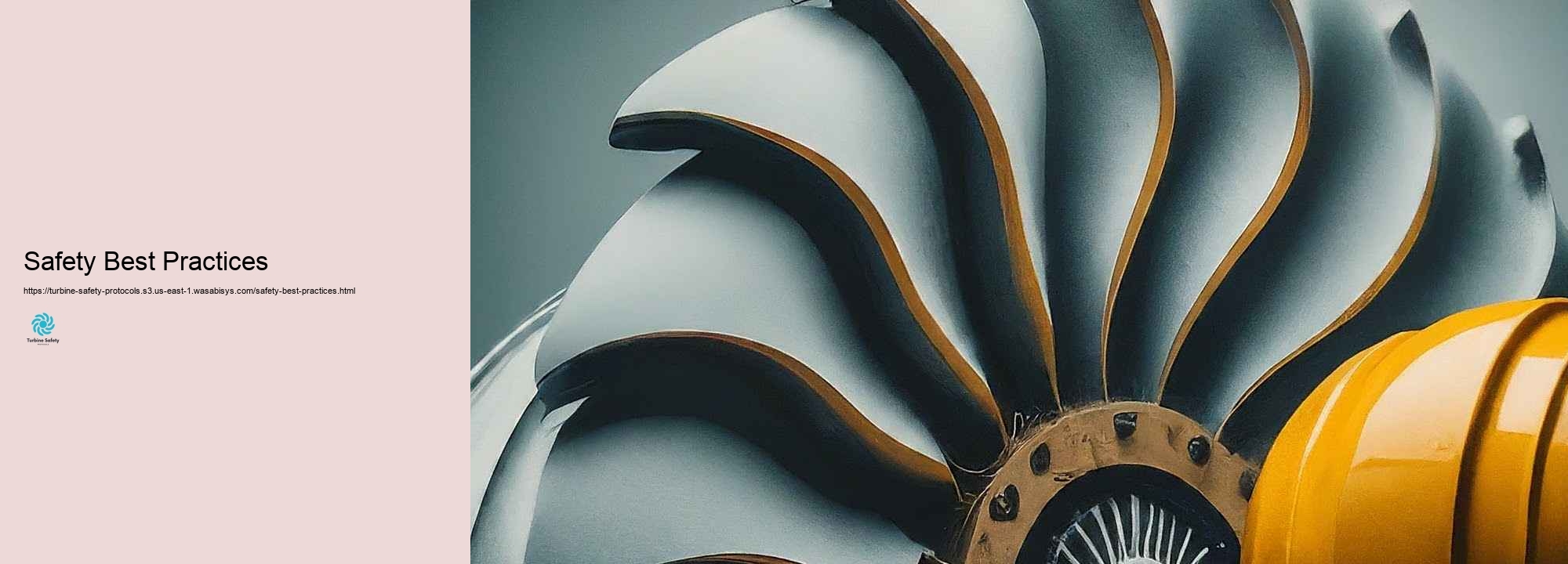
Safety devices plays a necessary duty in turbine treatments, functioning as the very first line of security versus prospective hazards and ensuring the health of employees operating in power generation centers. The diverse series of safety devices utilized in turbine operations mirrors the center and possibly unsafe nature of these settings, where warms, pressurized systems, revolving equipment, and electric risks are commonplace. Private Safety Devices (PPE) types the structure of safety tools in turbine treatments. Hard hats are important for shielding versus dropping things and head results, specifically in locations with over job or in constrained spaces within the turbine structure. Safety glasses or shatterproof glass guard the eyes from flying debris, dust, and prospective chemical splashes. In areas with high sound degrees, such as near operating turbines or in generator rooms, paying attention to defense in the kind of earplugs or earmuffs is critical to stay clear of lasting listening to damages. Steel-toed boots are usual shoes in turbine ambiences, protecting versus falling things and providing slip resistance on perhaps glossy surface areas. In places where there's a risk of arc flash or fire, flame-resistant garments is necessary. This certain clothing is developed to self-extinguish and provide an obstacle versus thermal power, reducing the severity of melt injuries in case of an electrical arc or flash fire. Loss protection equipment is particularly vital in turbine operations, especially for wind generators where operate at elevation dominates. Full-body harnesses, lanyards, and self-retracting lifelines are essential parts of an autumn arrest system. These systems are made to securely quit an autumn and reduction the forces applied on the body. Assistance factors, whether irreversible configurations or short-term setups, offer protected accessory factors for these systems. For wind turbine maintenance, specialized climbing up and placing devices may likewise be utilized to authorization employees to securely access various elements of the turbine structure. Respiratory system protection devices is required in certain turbine treatment scenarios. In circumstances where airborne toxins exist, such as throughout cleansing procedures or when dealing with certain chemicals, respirators or breathing gadget might be asked for. These can array from standard dust masks to a lot more intricate supplied-air systems, counting on the nature and focus of the air-borne threats. Lockout/Tagout (LOTO) tools is necessary for making certain that machinery and equipment are successfully de-energized throughout upkeep or repair service. This equipment generally includes locks, tags, and gizmos for separating power resources. Proper usage LOTO tools safeguards against the unforeseen start-up or release of conserved power, which might cause significant injury or fatality. Gas discovery devices is crucial in turbine operations, specifically in enclosed areas or locations where there's an opportunity for gas leaks. Mobile gas detectors can alert employees to the presence of flammable gases, oxygen shortage, or toxic gases such as carbon monoxide. In some centers, repaired gas exploration systems are mounted to supply continual security and automated alarm systems. Fire safety gadgets is a vital part of turbine procedure safety. This consists of fire extinguishers tactically located throughout the facility, fire reductions systems (such as sprinkler system or aeriform suppression systems), and emergency situation alarm system. In areas with specific fire hazards, such as those consisting of combustible liquids or electrical tools, specialized fire decreases devices might be utilized. Electric safety gadgets is extremely important in turbine operations as an outcome of the existence of high-voltage systems. Insulated tools, voltage detectors, and arc blink safety devices are critical for employees taking care of electric systems. Rubber shielding handwear covers, along with natural leather guards, provide safety and security versus electric shock and arc flash injuries. Protecting coverings and floor coverings can be used to cover fresh devices or to provide a protecting barrier for employees. Emergency circumstance response tools is important for handling possible accidents or instances. This contains first aid sets, automated outside defibrillators (AEDs), emergency situation eyewash terminals, and safety showers. In larger facilities, devoted emergency scenario reaction trucks or equipment caches may be maintained to sustain quick responses to events. Interaction tools plays a crucial function in safety throughout turbine procedures. Walkie-talkies permit workers to stay in call, particularly important in loud settings or when working in separated places of a big facility. Emergency interaction systems, including alarm and public address systems, are important for swiftly notifying employees to potential threats or launching discharge procedures. Confined area entrance devices is required for safely accessing and working in the restricted rooms generally discovered in turbine systems. This devices may consist of gas displays, air circulation blowers, tripods with winches for emergency situation gain access to, and supplied-air breathing device. Proper use of this gadgets is vital for protecting against crashes connected to oxygen deficiency, poisonous ambiences, or entrapment. Ergonomic devices, while generally disregarded, is essential for stopping resilient injuries connected with repeated tasks or undesirable stances. This can contain versatile job platforms, ergonomic devices made to decrease pressure, and mechanical training aid to assist with heavy aspects. Climate protection gadgets is specifically crucial for outside turbine treatments, such as wind cattle ranches. This can consist of serious environment gear for specialists running in extreme problems, in addition to lightning protection systems for the generators themselves. Spill reaction equipment is needed to quickly have and clean any type of chemical splashes or leakages that may take place throughout turbine procedures. This usually contains taking in products, control booms, and personal safety tools specific to the chemicals in operation at the facility. Rescue tools is a vital part of safety preparedness, particularly for wind turbine procedures where workers could requirement to be saved from heights. This can consist of specialized rescue harnesses, descent tools, and stretchers produced for confined space or high-angle rescue circumstances. Barrier and caution tools, such as safety cones, obstacle tape, and indication, play an essential responsibility in demarcating dangerous locations and managing gain access to to perhaps harmful areas within the turbine center.
Turbine safety protocols are made to make certain the risk-free procedure and upkeep of wind generators, which are crucial aspects in power generation. While safeguard are necessary, having durable emergency circumstance reaction and case management approaches in position is in a similar way crucial. These plans assistance minimize the impact of unanticipated occasions, guard staff members, and decrease downtime. Effective emergency reaction and situation administration are important for maintaining functional security and making sure the health of those related to turbine procedures. Emergency situation feedback planning entails developing comprehensive treatments for replying to potential incidents. This consists of identifying feasible risks, such as fires, electric shocks, or mechanical failings, and explaining the actions to be taken in each circumstance. The strategy needs to cover punctual activities, communication protocols, clearing therapies, and the obligations and responsibilities of all employees entailed. Routine updates and examinations of the emergency scenario comments method are important to warranty it stays suitable and effective. Incident protection and documentation are crucial parts of emergency scenario reaction and event management. All situations, despite just how small, has to be completely tape-recorded. This includes details of the incident, the actions taken, and any kind of injuries or damage gotten. Ideal papers helps in carrying out extensive exams, determining root causes, and using corrective actions to avoid future incidents. It furthermore functions as a beneficial resource for training and enhancing safety protocols. Training and drills are critical for making certain that all employees are prepared to respond successfully in emergency situation scenarios. Regular training sessions need to cover emergency situation therapies, using safety tools, and interaction protocols. Drills and simulations help improve this knowledge and assurance that staff members can act without delay and properly in real-world situations. Training should be customized to the certain demands of the turbine procedure and require to include both routine and high-risk scenarios. Trusted communication is crucial during emergency situation actions. Clear communication protocols should certainly be created to guarantee that all pertinent celebrations are informed without delay and properly. This includes interior communication among employee, along with outside interaction with emergency situation solutions and regulative bodies. Communication protocols must specify that need to be contacted, precisely how information should be passed on, and what details demands to be given. Case investigation is a crucial step in the event keeping track of procedure. It involves a total evaluation of the case to figure out its resource and including aspects. The evaluation should be conducted by a team with diverse understanding, consisting of safety specialists, engineers, and practical workers. The findings of the examination should be recorded and taken advantage of to apply rehabilitative activities, upgrade safety protocols, and deal training to avoid comparable incidents in the future. Rehabilitative activities and preventive measures are critical for making sure that incidents do not return. Based upon the findings of situation exams, rehabilitative activities needs to be required to address any type of shortages or powerlessness determined.
